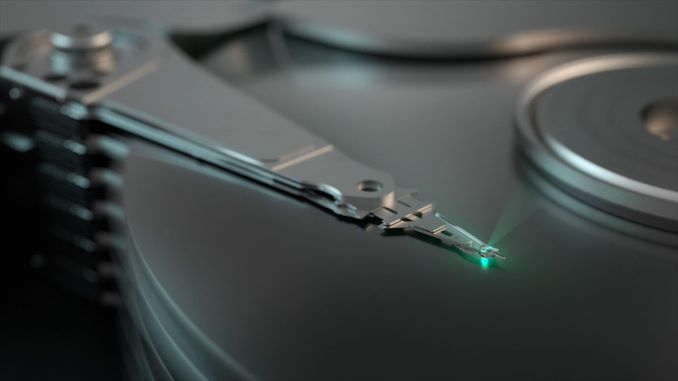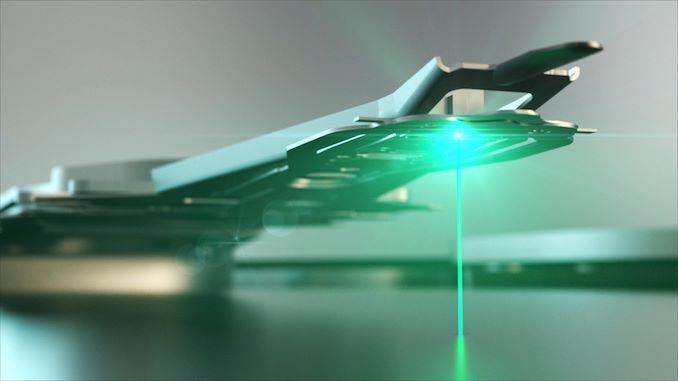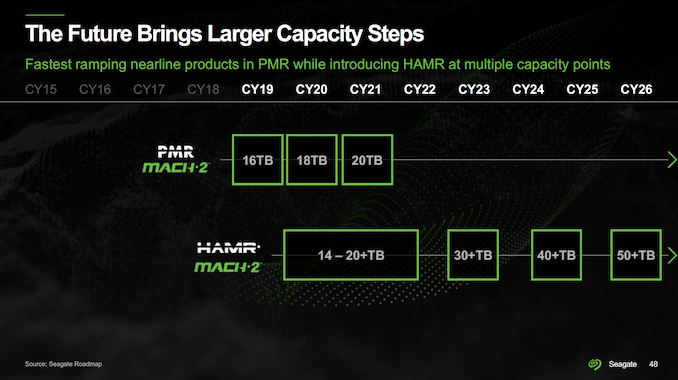Seagate Confirms 30TB+ HAMR HDDs in Q3, Envisions 50TB Drives in a Few Years
by Anton Shilov on January 27, 2023 6:00 PM EST
Seagate this week confirmed plans to launch the industry's first 30+ TB hard drive that uses its heat assisted magnetic recording (HAMR) technology, as well as reaffirming its commitment to release HDDs with capacities of 50 TB and higher in a few years. But before this happens, the company will release 22 TB and 24 TB HDDs that will rely on perpendicular magnetic recording (PMR) and shingled magnetic recording (SMR) technologies, respectively.
One More Play for PMR and SMR
Various energy assisted magnetic recording methods, such as HAMR, will be used for next generations of hard drives for years to come. But while PMR is running out of steam, it is still evolving. Seagate has managed to increase areal density enabled by its PMR + TDMR platform by around 10%, enabling 2.2 TB 3.5-inch HDD platters and thus 22 TB hard drives featuring 10 of such disks. Furthermore, by using shingled recording, these drives can have their capacity stretched to 24 TB.
These 22 TB and 24 TB Seagate Exos drives will likely be drop-in compatible with existing cloud datacenter hardware as well as infrastructure, and should not require extensive validation and certification procedures, unlike brand-new HAMR HDDs. As a result, Seagate's customers will be able to deploy such hard drives fairly quickly and increase storage density and storage capacity of their datacenters.
Seagate is now ramping up production of its 22 TB hard drives for datacenters, so expect the company to start their shipments shortly. Seagate is not disclosing when exactly it will officially launch its 22 TB and 24 TB parts, but we would expect them to arrive before the company introduces its HAMR-based HDDs; so think Q1 or Q2.
30+ TB HDDs Coming in Q3
In fact, Seagate has been shipping HAMR HDDs to select customers for evaluation as well as inside its own Lyve storage systems for a while, but those drives featured capacities akin to those of PMR/CMR HDDs and were not available in huge volumes. With Seagate's 2nd generation HAMR platform, the company is going after higher volumes, but it took the company quite some time to get there. The first pre-qualification high-capacity HAMR-based HDDs are only just now getting ready to head out to customers for evaluation.
"We are meeting or exceeding all product development milestones and reliability metrics, and we will be shipping pre-qualification units to key cloud customers in the coming weeks," said Dave Mosley, chief executive of Seagate.
Meanwhile, commercial HAMR hard drives with capacities of 30TB or higher will ship in third quarter of this year, which is in-line with what Seagate promised last year.
"As a result of this progress, we now expect to launch our 30-plus terabyte platform in the June quarter, slightly ahead of schedule," said Mosley. "The speed of the initial HAMR volume ramp will depend on a number of factors, including product yields and customer qualification timelines."
Initially Seagate will only offer its HAMR technology for its highest-capacity offerings for hyperscale datacenters, whom need maximum storage density and are willing to pay premium for the drives and for supporting infrastructure. As yields of HAMR-supporting media and the appropriate read/write heads increase, the technology will be applied for drives with lower capacities in a bid to cut down their production costs (fewer disks and heads, lower the costs). This is not going to happen overnight though, as the company needs to increase yields of HAMR drive components and the HDDs themselves to a comfortable level.
"I think this year, [the volume of HAMR HDDs] will probably still be relatively low," said the head of Seagate. "Then the faster we can get the yields and scrap and all the costs that we can control down on the heads and media, then the faster we'll be accelerating. I think that will happen in calendar year 2024 and calendar year 2025 will just continue to accelerate. The highest capacity points will be addressed, but also these midrange capacity points."
50+ TB HDDs Will Be Here in a Few Years
Seagate's launch of its first mass market 30+ TB HAMR hard drives platform will mark a milestone for the company and the whole industry. But apparently the company has another breakthrough to share at this time. The firm said this week that it had created 5 TB platters for 3.5-inch hard drives, which presumably entails new media, new write heads, and new read heads.
"It was nearly four years ago to the day that I first shared our lab results demonstrating 3 TB per disk capacities," explained Mosley. "And today, we have demonstrated capacities of 5 TB per disk in our recording physics labs."
For now, these platters are used on spinstands for evaluation and testing purposes, but platters like these will allow for 50 TB HDDs a few years down the line. Seagate's roadmap indicates that such hard drives will hit the market sometimes in calendar 2026.
It is unclear how thin the new platters are. But following current trends of nearline HDD evolution — increasing areal density and increasing number of platters per hard drive — it's not outside the realm of possibility that Seagate will find ways to integrate even more than 10 platters in future drives. In which case Seagate would be able to hit drive sizes even larger than 50 TB.
In any case, with ~3 TB platters in production, samples of ~30 TB HDDs shipping to customers, and 5 TB platters demonstrated in the lab, Seagate's HAMR roadmap seems to look quite solid. Therefore, expect hard drives to gain capacities rapidly in the coming years.












70 Comments
View All Comments
Ken_g6 - Friday, January 27, 2023 - link
Do SMR and HAMR go together for even larger storage drives?nandnandnand - Friday, January 27, 2023 - link
https://ieeexplore.ieee.org/document/6947937https://www.anandtech.com/show/14077/toshiba-hdd-r...
It's possible. I don't know if Seagate or WD plan to though.
name99 - Saturday, January 28, 2023 - link
Remember, from a 10,000 ft vantage point SMR is just a coding scheme, ie a way to write data given certain constraints. This is no different from cellphone coding (write data given the possibility of a bit error from noise) or flash coding (write data given the possibility of bad cells).The particular constraints of hard drives are that the storage medium (magnetic grains) are distributed at random sizes, orientations, and locations, so that you may have spots where these all come together so that the desired bit is recorded weakly or not at all. To deal with this, like flash, like cellular, we design a code that includes some redundant data, and whose precise design is based on the "noise structure" of the medium, ie the disk surface.
Now, what is interesting about disks compared to flash or cellular, is that the disk surface is 2D. So while traditional coding is one-dimensional, you can gain some additional efficiency by making the code two dimensional. SMR is a particular version of this with an additional constraint that the write head is wider than the read head. But even in the absence of that constraint, what I've said is generically true. The only way around it is to remove the noisiness, the randomness, in the storage medium. This is in principle possible with so-called patterned media, but it's unclear that the economics will ever go down that road.
So the way I see it, if the only real use case for hard drives is ever denser storage, then 2D coding has to be part of that future. And 2D coding comes with the constraints/side effects of SMR, even if it's not in the precise form of SMR. However probably for most use cases the worst side effects can be hidden with a flash cache.
ballsystemlord - Friday, January 27, 2023 - link
@Anton, I think you typed 22TB where you meant to type 24TB, " Furthermore, by using shingled recording, these drives can have their capacity stretched to 22 TB."xane - Friday, January 27, 2023 - link
What about the elephant in the room? Namely, the speed. Are these SATA drives? It'll take a week to copy lolnandnandnand - Saturday, January 28, 2023 - link
https://www.pcmag.com/news/seagate-creates-an-nvme...Seagate did demo an NVMe HDD in 2021. Multi-actuator technology could push speeds past the SATA 3.0 limit. It will still be slow.
abufrejoval - Sunday, January 29, 2023 - link
That's fine, HDDs are the new tape: You don't copy drives, you archive files you believe you'll need rarely, if ever.But yes, I am quite glad NVMe is so affordable these days, because I do remember trying to build for bandwidth with wide RAIDs.
Silver5urfer - Tuesday, January 31, 2023 - link
Oh yea the MUH PCIe speeds, right. They max out at garbage 4TB and that is very expensive TLC with 5000TBW from Seagate Firecuda rest are junk. Also sequential on NVMe is so pathetic. The only solution was Optane which is a real breakthrough in Technology with sky high endurance that not even SLC can dream of and insanely consistent sequential or any type of workload. Too bad Intel got bloated with other junk and killed Optane.Oh please buy that PCIe 5.0 SSD with active tiny fan on it for those muh 10gbps speeds. While I just stick with my reliable WD Gold with OptiNAND which works without any issues and does not blow up in flames.
The alternative is SAS on Consumer mobos, that will let SAS Multi Actuator drives perform at high levels plus no need of 6x ports or scarce 8xSATA just buy a conversion adapter and done. Or even the U.3 standard which is backwards compat with SATA, NVMe, PCIe, U.2 anything. Enterprise has solid tech which will never come to consumers because of greed and idiotic consumer sheep.
TheinsanegamerN - Tuesday, January 31, 2023 - link
8TB NVMe drives exist. TLC even!Silver5urfer - Wednesday, February 1, 2023 - link
Sabrent 8TB TLC trash with same endurance as Firecuda 4TB ? Thanks but no thanks for that mess and which costs $1200.